
Within that declaration, specify the BIND_CHOOSER_TARGET_SERVICE permission and an intent filter with the SERVICE_INTERFACE action. To enable direct share targets, you must define a class that extends the class, and declare your ChooserTargetService in the manifest. Using the Share menu, users can directly share content to targets within other apps. These APIs help make sharing quick and intuitive for users. Direct ShareĪnother new feature is the ability to define direct share targets that launch a specific activity in your app. Developers can also now disable/re-enable safe boot, and prevent plugged in devices’ screen from turning off, enabling a more singular and focused experience for corporate-oriented applications. System updates can now be automatically accepted or postponed by setting a system update policy with tSystemUpdatePolicy().

Third-party applications can also call a number of DevicePolicyManager methods, allowing more flexibility in COSU app design. Boasting a number of enhancements, the DevicePolicyManager class now incorporates methods such as setKeyguardDisabled() and setStatusBarDisabled(), which allow significant improvements in the use of corporate-owned, single-use (COSU) devices. With Android Marshmallow, developers now have more tools than ever to build applications for corporate and enterprise environments. Here are some of our favorites so far: Android for Work We looked through the Android 23 APIs and their documentation to find noteworthy features and their APIs. With Android Marshmallow, Google has made some improvements over previous versions of the OS and added a number of new features to the Android platform from the new permission system to the assist APIs, Marshmallow is turning out to be a worthy successor to last year’s Lollipop. Google has also finalized the Android version 23 APIs, and developers can download the official Android 6.0 SDK via the SDK Manager in Android Studio. We now know this version of Android as Android 6.0 Marshmallow. The Android M developer preview gave developers a clear timeline to test their apps, and an opportunity to explore the new features the latest version of Android has to offer.


Earlier this year Google unveiled its new version of Android - code named Android M - and like with Android Lollipop, we also got a developer preview.


 0 kommentar(er)
0 kommentar(er)
